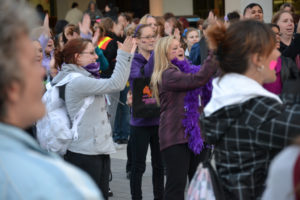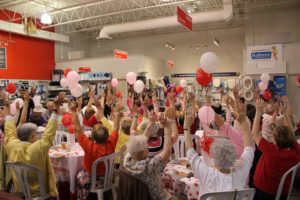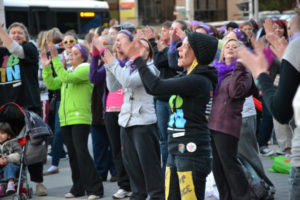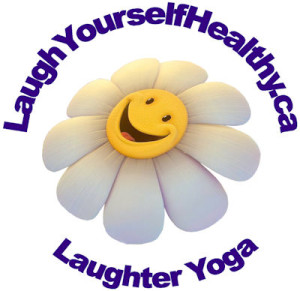Would you take up an activity, or encourage your children to engage in it if you knew that it could reduce the risk of dyslexia and dyscalculia, improve cognitive abilities and special task performance, social integration, handwriting and spelling and make you feel more focused and less tense?
Apparently all of the above is as easy as clapping your hands.
New research has found a clear link between hand-clapping and neurological development that aids cognitive thinking, writing and literacy.
A researcher at Israel’s Ben-Gurion University of the Negev (BGU) conducted the first study of hand-clapping songs, revealing a direct link between those activities and the development of important skills in children and young adults, including university students.
According to lead researcher, Dr. Idit Sulkin, the benefits of hand-clapping games and songs can be seen throughout the school years and even into university students and young adults. Sulkin also found that children who sing hand-clapping songs in the schoolyard during breaks have neater handwriting and fewer spelling mistakes than their peers who did not engage in clapping songs.
The findings indicate that children who do not play hand-clapping games and songs are at increased risk for learning disabilities and developmental problems.
During the study, “Impact of Hand-Clapping Songs on Cognitive and Motor Tasks” Sulkin found that introducing hand-clapping songs to children in school can improve their cognitive abilities. Sulkin found that children spontaneously engage in games and songs that involve hand-clapping from kindergarten to around the third grade, at which point the children seem to “grow out” of the past time in favour of sports. Sulkin believes this is representative of a natural developmental process that children go through between the ages of seven and ten.
The researchers also found that hand-clapping activities had a positive effect on adults as well, with participants reporting feeling more relaxed and better able to concentrate as well as elevated moods.
As part of the study, Sulkin went to several elementary school classrooms and engaged the children in either a music appreciation program sanctioned by the board of education or hand-clapping songs training – each lasting a period of 10 weeks.
 “Within a very short period of time, the children who until then hadn’t taken part in such activities caught up in their cognitive abilities to those who did,” Sulkin says. But this finding only surfaced for the group of children undergoing hand-clapping songs training. The result led Sulkin to conclude that hand-clapping songs should be made an integral part of education for children aged six to ten, for the purpose of motor and cognitive training and to serve as a developmental platform to enhance children’s needs – emotional, sociological, physiological and cognitive. It’s a transition stage that leads them to the next phases of growing up.”
“Within a very short period of time, the children who until then hadn’t taken part in such activities caught up in their cognitive abilities to those who did,” Sulkin says. But this finding only surfaced for the group of children undergoing hand-clapping songs training. The result led Sulkin to conclude that hand-clapping songs should be made an integral part of education for children aged six to ten, for the purpose of motor and cognitive training and to serve as a developmental platform to enhance children’s needs – emotional, sociological, physiological and cognitive. It’s a transition stage that leads them to the next phases of growing up.”
There are 39 acupuncture points and reflection areas for almost all the organs. Clapping hands vibrates the energy and unclogs the 14 meridians simultaneously. When you clap your hands, place them together as if in prayer mode. That way you activate all 39 acupuncture points and reflection areas.
This simple routing only takes eight to ten minutes for a 1000 claps. You will feel warmness, even sweat on both hands and feet. This is a process to normalize the organ functions and you will see the results after about two months. Remember, always do the clapping while walking around so you move the energy around the entire body.
Clapping is the warming up exercise to loosen up and remove inhibitions and shyness.
Clap hands parallel to each other for full finger-to-finger and palm-to-palm contact, thus stimulating Acupressure points in our hands to increase energy levels.
- Rhythm is added to the clapping, to further increase energy levels and group synchronicity, often a 1-2, 1-2-3 rhythm.
- Movement is then added. There are many variations, but most move hands up and down and swing from side to side, with corresponding movements of the hands and feet.
- A simple chant is added to the clapping, normally HO, HO, HA-HA-HA. These are heavy exhalations that come from the belly, to stimulate diaphragmatic breathing.
- Adding dance movements boosts feelings of happiness and joy. Enthusiastic clapping, chanting and movement, help build positive energy, helps get the diaphragm moving, and creates a positive group dynamics in preparation for Laughter.
Yes, clapping hands is a simple and very effective way to raise and move body’s Yang energy. It not only makes you feel more energetic, but also eases or cures many chronic diseases such as asthma, heart, lung and kidney problems and circulation, if you can persistently do this every day one hour after a meal (better not in the evening otherwise you might get too excited to go to sleep).
Now then, let’s get clapping.
